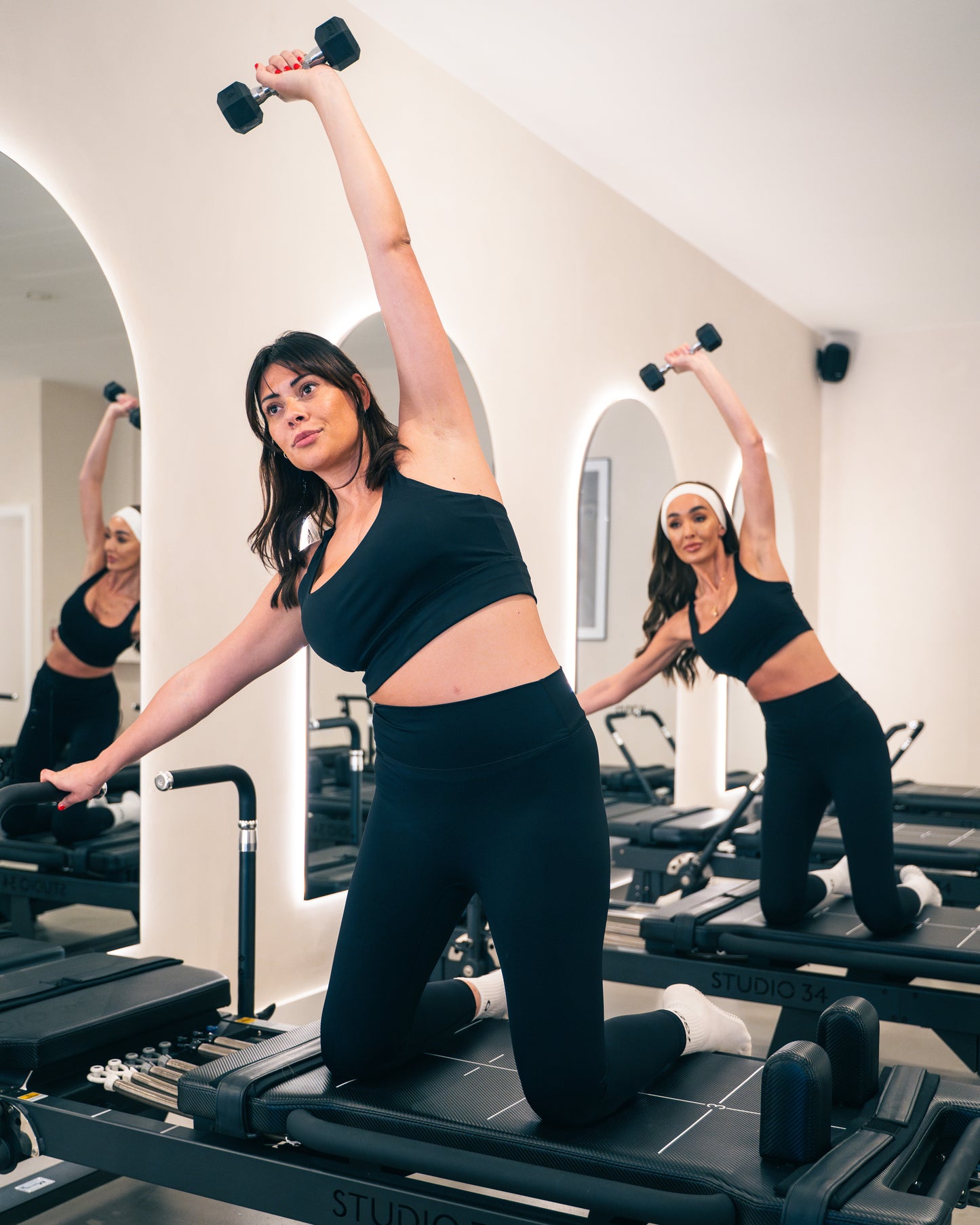
Pilates has been a popular choice for those looking to improve their core strength, flexibility, and overall fitness for a long time, but with the rise of Reformer Pilates, many are left wondering: what's the difference between the two? And, which one might be better suited to your fitness needs?
Here, we’ll dive into the benefits, and differences between Pilates and Reformer Pilates.
What’s the Difference Between Reformer Pilates and Pilates?
The term "Pilates" typically refers to mat-based Pilates, which involves performing exercises on a mat using your body weight as resistance. This form of Pilates focuses on controlled movements that engage the core, improve flexibility, and enhance posture. Mat Pilates can be done almost anywhere and requires minimal equipment.
Traditional Pilates: All you need is a mat and sometimes small props like resistance bands or a Pilates ring.
Reformer Pilates, on the other hand, involves the use of a specialised piece of equipment called the Reformer. The Reformer consists of a sliding ‘bed’, springs, and ropes, allowing for a more dynamic range of exercises. The machine provides varying levels of resistance, making it suitable for both beginners and those who are advanced. The resistance provided by the Reformer can intensify or assist the exercises, making it a great tool for building strength, improving balance, and enhancing flexibility.
Reformer Pilates: You’ll need to visit a studio that specialises in Reformer and has the correct equipment.
Concentration, Control, Centre, Flow, Precision and Breathing
Pilates, both on the mat and the Reformer, is based on a series of movements designed to target specific muscle groups, with a strong emphasis on the core. The exercises in Pilates are rooted in six key principles: concentration, control, centre, flow, precision, and breathing. These principles ensure that each movement is executed with purpose and mindfulness, enhancing the overall effectiveness of the workout.
Mat Pilates exercises include the Hundred, Roll-Up, Leg Circles, and the Swan, all of which are designed to engage the core muscles, lengthen the spine, and improve body alignment. Reformer Pilates includes these same exercises but also adds more dynamic movements because the bed allows for a broader range of motion and can provide either resistance or assistance, depending on the exercise and the springs' settings.
How often per week should you do Pilates?
Consistency is key when it comes to Pilates, whether you're on the mat or the Reformer. To see noticeable improvements in strength, flexibility, and overall fitness, it's generally recommended to practice Pilates two to three times per week.
For beginners, starting with two sessions per week allows the body time to adapt and recover. As you become more comfortable and your fitness level improves, increasing to three or four sessions per week can help you continue progressing.
If you're using Reformer Pilates as a supplementary workout alongside other forms of exercise, two sessions per week can be sufficient to maintain and enhance your overall fitness.
Is One Better for People with Injuries Over the Other?
Pilates - both on the mat and on the Reformer machine - is often recommended for rehabilitation and injury prevention, but the choice between the two can depend on the nature of the injury and the individual's specific needs.
Mat Pilates: For those with injuries, mat Pilates can be a good option, especially if the injury is related to the lower back or core. The controlled, low-impact movements help build strength and stability without putting undue strain on the joints. However, modifications may be necessary depending on the injury. These will usually be offered by your instructor anyway, to cover all abilities.
Reformer Pilates: Reformer Pilates is often preferred in a rehabilitative setting because the machine provides more support and control. The springs on the Reformer can assist in movements, reducing the strain on injured areas while still allowing for a full range of motion. This makes it ideal for those recovering from injuries, as exercises can be tailored to avoid aggravating the injury while still working to strengthen and stabilise the affected area.
Both Pilates on a mat, and Reformer Pilates, offer unique benefits that cater to a wide range of fitness levels and goals!
Whether you're looking to build core strength, improve flexibility, or recover from an injury, incorporating Pilates into your fitness routine can provide a low-impact yet highly effective workout. The choice between mat and Reformer Pilates ultimately depends on your personal preferences, fitness level, and specific needs, but both forms offer a path to a stronger, more balanced body. You could even mix it up and do one session of each per week!
TRADITIONAL MAT PILATES
Difficulty Level: (5) ⭐⭐⭐⭐⭐ - (7) ⭐⭐⭐⭐⭐⭐⭐
Convenience (How easy is it to fit into a lifestyle): (9) ⭐⭐⭐⭐⭐⭐⭐⭐⭐
Accessibility for beginners (Can be more difficult to get form correct): (8) ⭐⭐⭐⭐⭐⭐⭐⭐
REFORMER PILATES
Difficulty Level: (6) ⭐⭐⭐⭐⭐⭐ - (9) ⭐⭐⭐⭐⭐⭐⭐⭐⭐
Convenience (How easy is it to fit into a lifestyle): (4) ⭐⭐⭐⭐⭐
Accessibility for beginners (Form and Technique): (6) ⭐⭐⭐⭐⭐⭐
At iGD, we specialise in compression wear for Traditional Mat Pilates and Reformer. Our compression technology offers gluteal support for lower leg exercises and stretching, while the 4-way stretch fabric makes the products super comfortable. Lots of our items are body sculpting which allows you to squat deeper and train harder.
Here’s what we recommend…
Our top compression picks for Pilates:
In cold weather, you can also add…






